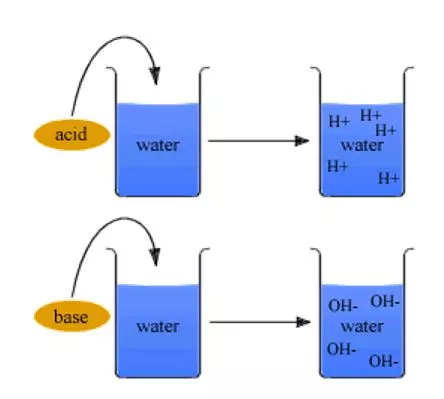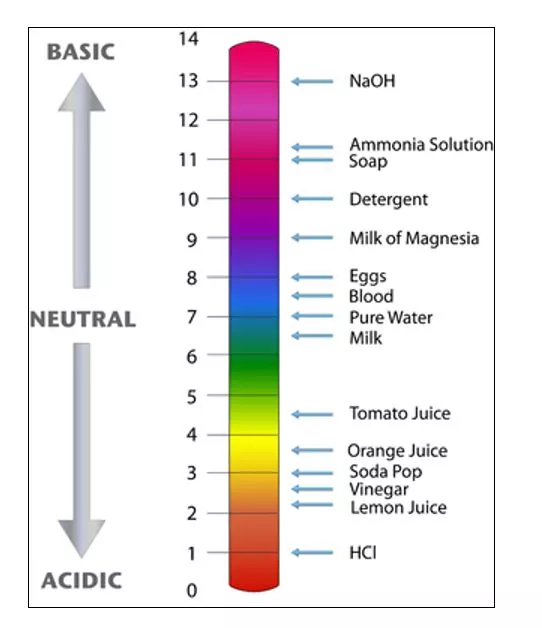Introduction To Acids And Bases
Acids and Bases: Properties, pH, Concepts & Limitations
Earlier the norms for the classification of acids and bases were the experimentally observed characteristics of aqueous solutions. An acid was known as a substance whose water solution tastes sour, turns blue litmus red, neutralizes bases. A base was known to be a substance if its aqueous solution has a bitter taste, neutralizes acids, turns red litmus blue, and so on.
Arrhenius Concept
As per the Arrhenius concept, all substances that yield H+ ions when dissolved in water are called acids, while those that ionize in water to provide OH- ions are termed as bases.
HA  H+ + A- (Acid)
H+ + A- (Acid)
BOH  B+ + OH- (Base)
B+ + OH- (Base)

Hence, HCl is acid as it donates H+ ions in water. NaOH is a base as it gives OH- ions in the water.
HCl  H+ + Cl-
H+ + Cl-
NaOH  Na+ + OH-
Na+ + OH-
Acids and bases that ionize entirely in the solutions are called string acids and bases. Some acids and bases are dissociated to a limited degree in solutions, and they are termed weak acids and bases resp. Examples of strong acids are HCl, HNO3, H2SO4, HCIO4, etc. and examples of strong bases are NaOH, KOH, (CH3)4NOH are strong bases.
Free H+ ions are highly reactive, so they are not able to exist in water. The H+ion combines with other water molecules to form hydronium ion (H3O+) molecules, i.e., it has a strong tendency to get hydrated.
The chemical reaction between a base and an acid is termed as neutralization. As per, Arrhenius concept, the neutralization in aqueous solution involves the reaction between H+ and OH- ions or hydronium and OH-. It can be expressed as:-
H3O+ + OH-  2H2O
2H2O
Limitations of Arrhenius Concept
The presence of water is categorically necessary for the acidic or basic properties. HCl in the dry state shall not act as an acid. HCl is considered as an acid only when dissolved in water and not in any other solvent.
TheArrhenius Conceptconcept does not elucidate the acidic and basic character of substances in non-aqueous solvents.
The neutralization process is restricted to those reactions that can occur in aqueous solutions only, although reactions involving salt formation do happen in the absence of solvent.
The concept does not explain the acidic character of specific salts such as AlCl3 in the aqueous solution.
Bronsted-Lowry Concept: Proton-Donor-Acceptor Concept
As per the Bronsted-Lowry concept, an acid is a substance that can donate a proton, i.e., a hydrogen ion, H+, to other substances, whereas a base is a substance that can accept a proton from an acid.
In simple terms, acid is a proton-donor (protogenic), and a base is a proton acceptor (protophilic).
Consider the reaction,
HCl + H2O  H3O + Cl-
H3O + Cl-
In the above reaction, HCl acts as an acid because it donates a proton to the water molecule. Whereas, water acts as a base by accepting a proton from the acid HCl.
When an acid gives a proton, the remaining part of it tends to regain a proton. Therefore, it acts as a base.
Acid  H+ + Base
H+ + Base
The acid and base that differ by a proton are known to make a conjugate pair. Consider the following reaction.
CH3COOH + H2O  H3O+ + CH3COO-
H3O+ + CH3COO-
Such pairs of substances that can be formed from one another by loss or gain of a proton are called conjugate acid-base pairs.
Acid1 + Base2  Base1 + Acid2
Base1 + Acid2
Hence, any acid-base reaction involves two conjugate pairs, i.e., when an acid reacts with a base, another acid and base are formed.
Thus, every acid has its respective conjugate base, and every base has its respective conjugate acid.
Particular molecules contain characters of both an acid and a base. These are known as amphiprotic or atmospheric.
A few examples are H2O, NH3, CH3COOH, etc.
The strength of an acid is based upon its tendency to lose its proton; however, the strength of a base depends on its tendency to accept the proton.
Acid
Conjugate base
KClO4
(Perchloric acid)
(Perchlorate ion)
H2SO4
(Sulphuric acid)
(Hydrogen sulphate ion)
HCl
(Hydrogen chloride)
Cl-
(Chloride ion)
HNO3
(Nitric acid)
(Nitrate ion)
H3O+
(Hydronium ion)
H2O
(Water)
(Hydrogen sulphate ion)
(Sulphide ion)
H3PO4
(Ortho phosphoric acid)
H2
(Dihydrogen phosphate ion)
CH3COOH
(Acetic acid)
CH3COO-
(Acetate ion)
H2CO3
(Carbonic acid)
(Hydrogen carbonate ion)
H2S
(Hydrogen sulphide)
(Hydorsulphide ion)
NH3+
(Ammonium ion)
NH3
(Ammonia)
HCN
(Hydrogen cyanide)
CN-
(Cyanide ion)
C6H5OH
(Ethyl alcohol)
C6H5O-
(Phenoxide ion)
NH3
(Ammonia)
OH-
(Hydroxide ion)
CH4
(Methane)
C2H5O-
(Ethoxide ion)
In acid-base strength series, all the acids positioned above H3O+ in aqueous solution drop to the acidic strength of H3O+. In the same way, the basic strength of bases below OH- drop to the strength of OH- in aqueous solution. It is called leveling effect.
The strength of acid also relies upon the solvent.
Lewis Concept of Acids and Bases
In 1939, the particular concept was proposed by G.N. Lewis. According to the Lewis concept, a base is defined as a substance that can provide a pair of electrons to make a coordinate bond, whereas an acid is a substance that can accept a pair of electrons.
The acid is also called as electron acceptor or electrophile, while the base is known as electron donor or nucleophile.
Acid-Base
Lewis Concept of Acids and Bases are more general than the Bronsted Lowry concept.
Note: All Bronsted bases are Lewis bases; however, some of the Bronsted acids are not Lewis acids.
Limitations of Lewis Concept
It is not possible to arrange Lewis Acid & Base in any order of their relative strength owing to the dependency of the strength of the Lewis acids and bases on the type of reaction.
The choice of which definition of acids and bases one chooses to use in a particular instance depends mainly on the sort of chemistry that is studied. But the Arrhenius concept is a satisfactory and simplest concept for dealing with reactions in aqueous solutions. It elucidates satisfactorily the strength of acids and bases in aqueous solutions, neutralization, salt hydrolysis, etc.
pH of Acids and Bases
The nature of a particular solution (acidic, alkaline or neutral) can be expressed in terms of either hydrogen ion concentration or hydroxyl ion concentration. It is suitable to express acidity or alkalinity of a solution by referring to the concentration of hydrogen ions only.
pH measurement is done with pH paper and pH meter.

Since H+ ion concentration can vary within an extensive range from 1 mol per litre to about 1.0× 10-14mol per litre, a logarithmic notation has been introduced by Sorensen, in 1909, to simplify the expression of the quantities. The notation used is called the pH scale.
What is pH?
The pH of a solution is defined as the negative logarithm of the concentration (in mol per litre) of hydrogen ions which it contains,
pH of the solution is the logarithm of the reciprocal of H+ ion concentration.
The hydrogen ion concentrations are represented in terms of the numerical value of negative power to which 10 must be raised. This numerical value of negative power is termed as pH, i.e.,
pH = – log aH+ ( aH+ is the activity of H+ ions).
The activity of H+ ions is the concentration of free H+ ions in a solution. Free H+ions is at a large distance from the other ion to avoid intramolecular pull. In dilute solutions, the activity of an ion is the same as its concentration since the number of solvent molecules would separate the two ions. For concentrated solutions, the activity would be much less than the concentration itself.
Therefore, the expression of pH can be altered for dilute solutions as,
pH = – log [H+].
Just as pH represents the hydrogen ion concentration, the pOH indicates the hydroxyl ion concentration, i.e.,
pOH = -log [OH-]
Considering the relationship,
[H+][OH-] = Kw = 1 x 10-14
Taking log on both sides, we have
log [H+] + log [OH-] = log Kw = log (1 x 10-14)
or -log [H+] - log [OH-] = -log Kw = -log (1 x 10-14)
or pH + pOH = PKw* = 14
i.e., sum of pH and pOH is equal to 14 in any aqueous solution at 25°C.
Limitations of pH Scale
pH values do not give us an instant idea of the relative strengths of the solutions. For instance, solution of pH = 1 has a hydrogen ion concentration 100 times that of a solution having pH 3 (not three times).
pH value of zero is obtained in 1 N solution of the strong acid. In case the concentration is 2 N, 3 N, 10 N, etc. The respective pH values will be negative.
A solution of an acid with very low concentration, say 10-8 N, cannot have pH 8, as represented by pH formula, but the actual pH value will be less than 7.

Acid
Conjugate base
KClO4
(Perchloric acid)
(Perchlorate ion)
H2SO4
(Sulphuric acid)
(Hydrogen sulphate ion)
HCl
(Hydrogen chloride)
Cl-
(Chloride ion)
HNO3
(Nitric acid)
(Nitrate ion)
H3O+
(Hydronium ion)
H2O
(Water)
(Hydrogen sulphate ion)
(Sulphide ion)
H3PO4
(Ortho phosphoric acid)
H2
(Dihydrogen phosphate ion)
CH3COOH
(Acetic acid)
CH3COO-
(Acetate ion)
H2CO3
(Carbonic acid)
(Hydrogen carbonate ion)
H2S
(Hydrogen sulphide)
(Hydorsulphide ion)
NH3+
(Ammonium ion)
NH3
(Ammonia)
HCN
(Hydrogen cyanide)
CN-
(Cyanide ion)
C6H5OH
(Ethyl alcohol)
C6H5O-
(Phenoxide ion)
NH3
(Ammonia)
OH-
(Hydroxide ion)
CH4
(Methane)
C2H5O-
(Ethoxide ion)

pH = – log [H+].
Similar Questions
Introduction|Strong Acid And Weak Acid|Acid Rain|Base|Difference Between Acid And Base|OMR
View SolutionLewis Acid And Base
View SolutionIntroduction OF Amino Acid
View SolutionConcept of Acids and Bases
View SolutionBronsted Lowry Acids And Bases
View SolutionConcept of Acids & Bases
View SolutionIntroduction to ionic and acid base concept
View SolutionMolecular Biology-Introduction Nucleic Acids DNA-Structural Parts OF DNA Laws and Rules Governing the Structure OF DNA Base Ratio
View SolutionIllustration Based on Basic Identites and Introduction Allied Angles
View SolutionChemical Properties Of Acids And Bases
View Solution

